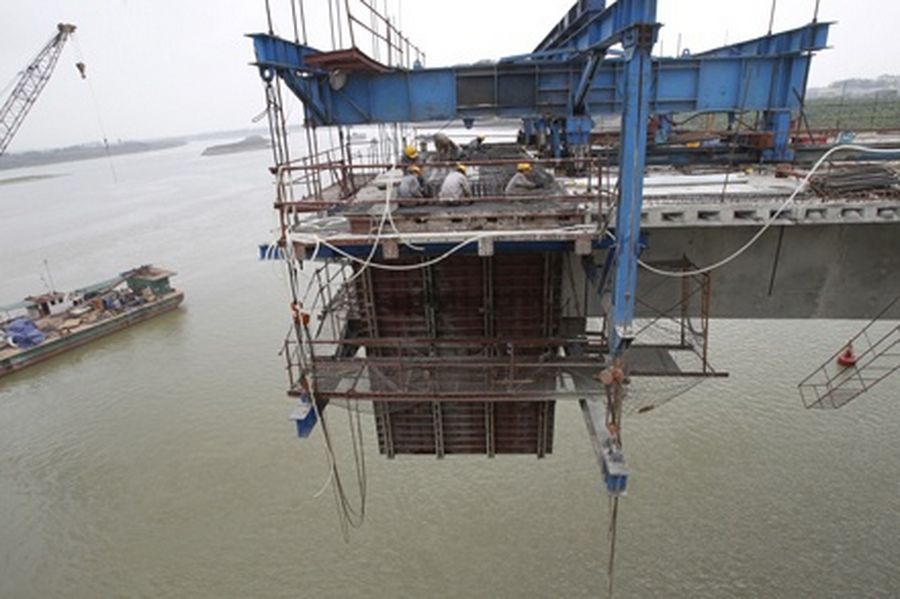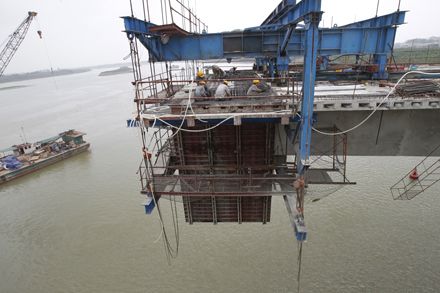The global financial crisis laid bare the link between the world’s financial markets and global trade volumes. For Asian companies, tougher banking regulations and European deleveraging are only adding to the challenge.

Source: Reuters/Kham
Labourers work on a bridge construction site, across the Duong river outside Hanoi.
The banking regulators behind the Basel III standards may not have been targeting trade finance when they set out rules on capital adequacy and liquidity management, but they are still forcing banks to rethink their approaches to this low-risk, short-term business.
The International Chamber of Commerce, in its latest report on global trade finance risks published on April 16, warns that Basel III will have a “profound impact” on trade finance. Confirmed letters of credit will require higher levels of capital, while leverage limits will dent the use of off-balance-sheet LCs and liquidity management rules will lead to higher funding costs for trade finance products.
A survey that the Asian Development Bank conducted in late 2012 revealed that banks would reduce, by an average of 13%, their support for trade finance if Basel III is fully implemented. The Basel committee has eased some liquidity rules for trade finance since the survey was carried out, but the threat to the business is still present.
With trade credit already under pressure from the retreat of European lenders, the impact of any further withdrawal will be especially painful for importers and exporters in Asia’s poorer countries.
“We found that US$1.6trn of demand for global trade finance was unmet, with US$425bn of that in developing Asia,” said Steven Beck, head of the ADB’s trade finance programme, pointing to the same 2012 survey.
Historical data does not exist to show how that compares to previous years, but one indicator – demand for the assistance of multilateral development banks like the ADB – suggests that the gap is widening.
“In smaller jurisdictions, the average bank is pulling out because it’s too much hassle”
The ADB’s trade finance programme, admittedly a relatively new project, supported US$4bn of trade in 2012 through 2,032 transactions involving 1,577 small and medium-sized enterprises, up from US$3.5bn in 2011 and US$2.8bn in 2010.
The programme aims to bridge the gap between demand for trade credit and the private sector’s appetite for risk. As global financiers have no shortage of credit limits in place for China or India, the project focuses on less-developed countries, such as Vietnam, Pakistan or Mongolia.
Anecdotal evidence suggests that Asian lenders, including those from Japan and Australia, have taken up some of the slack resulting from deleveraging European banks, and Beck notes that global trade finance volumes are becoming more concentrated among a group of around 11 banks, but may hurdles remain – especially in lower-rated countries.
More stringent anti-money laundering and know-your-customer requirements are also having a big impact on transaction costs. “In smaller jurisdictions, the average bank is pulling out because it’s too much hassle,” said Beck.
Non-compete clause
As well as providing credit, the ADB aims to encourage private-sector financiers to support trade in emerging markets in showing that the risks associated with trade credits are very low.
“The second objective is to make ourselves redundant,” said Beck.
The ADB funded the initial phase of the ICC’s Trade Finance Register, collating data on global trade financing and default rates. The resulting statistics confirm that trade finance is a safe asset, and have become important in discussions with global and local banking regulators, especially amid fears over the impact of Basel III rules on the availability of trade finance.
The ICC’s latest report in April showed a default rate of just 0.021% from 8.1m short-term trade finance deals that 21 participating banks reported for 2008–11. Although not directly comparable, the default rate is far lower than the 2.41% observed during that period on Moody’s-rated instruments– and still far lower than the agency’s one-year default rate for A1 counterparties from 1983 to 2011.
Figures like these have already encouraged banks and insurance companies to increase their participation in the trade finance market.
“The ICC Trade Register has been instrumental in fostering dialogue with regulators on a global scale. The integrity of the data is proven and is a strong incentive for other banks to participate,” said WTO director general Pascal Lamy.
Beck sees a more granular approach as the next step.
“For markets like Pakistan, the country rating alone will prevent most financial institutions from setting up lending limits. If we can demonstrate the number of letters of credit where Pakistani banks have defaulted, that can be a powerful argument to convince them otherwise,” he said.
As powerful as that message may be, however, many challenges remain. Financial communications platform Swift recorded a further decline in total trade finance traffic in 2012, with fourth-quarter volume down 2.8% year on year. While Europe accounted for most of the decline, it is clear that importers and exporters in Asia’s growing economies also need more financial support.
MDBs are relative newcomers to the trade finance arena, but their support appears to be gaining in importance.
To see the digital version of this report, please click here.
